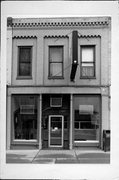Property Record
109 W MAIN ST
Architecture and History Inventory
| Historic Name: | Edward Johnson Drug Store; Eberle; Stapleton |
|---|---|
| Other Name: | Domino's Pizza |
| Contributing: | Yes |
| Reference Number: | 77039 |
| Location (Address): | 109 W MAIN ST |
|---|---|
| County: | Jefferson |
| City: | Watertown |
| Township/Village: | |
| Unincorporated Community: | |
| Town: | |
| Range: | |
| Direction: | |
| Section: | |
| Quarter Section: | |
| Quarter/Quarter Section: |
| Year Built: | 1855 |
|---|---|
| Additions: | 1986 |
| Survey Date: | 1986 |
| Historic Use: | small retail building |
| Architectural Style: | Commercial Vernacular |
| Structural System: | |
| Wall Material: | Brick |
| Architect: | |
| Other Buildings On Site: | |
| Demolished?: | Yes |
| Demolished Date: | 0 |
| National/State Register Listing Name: | Main Street Commercial Historic District |
|---|---|
| National Register Listing Date: | 6/2/1989 |
| National Register Multiple Property Name: |
| Additional Information: | This building was a drug store throughout most of its history. The building was built in the 1850s for Edward Johnson, who operated the oldest drug store in the community. Johnson came to Watertown in 1843 and began operating a drug store shortly thereafter. Johnson operated the drug store here until 1873 when he sold it to druggists Gustav and Herman Eberle, who operated the store here until about 1885 when they moved to 204 E. Main. They operated the businesses there until the mid 1910s. After the Eberles, Thomas Thomson operated the drug store here until around 1890. At this time Edward Stapleton took over and operated here until the early 1920s. After this, it was the Lou Uecker drug store and then the Doerr Pharmacy until at least 1930. This building is significant for local history under National Register criterion A because it was the Edward Johnson drug store, the oldest drug store firm in the community. The building also contributes to the commercial significance of the Main Street Commercial Historic District because it housed a drug store between its date of construction and the mid twentieth century. The local druggist was often the only medical service available to nineteenth century citizens. During the era when medicine offered mostly non-effective and variable treatment, the pharmacist dispensed the products that, at least in some cases, could offer symptomatic relief. This particular drug store was the oldest in the community, and in fact, was a pioneering business, being establihed in 1843 when Watertown's commercial district was very small. Because of the importance of Johnson's business, the building meets the criteria for local historical significance as well as being contributing to the commercial significance of the historic district. Constructed in the late 1850s for Watertown's first known druggist Edward Johnson, this two-story rectangular cream brick building exhibits the denticulated moulded brick cornices typically found on 19th century vernacular commercial buildings. rectangular windows with straight flat stone lintels and sills and one over one lights are located in the recessed panels on the second story of the three bay facade. Dentil trim ornaments the top edge of the recessed panels. Although the glass in the store front has been replaced, the fluted iron columns of the earlier store front and the recessed entrance door flanked by side lights and topped by a transom window remains on the building. A shed roofed one-story porch is located at the rear. The Johnson building basically is similar in design to the adjacent vernacular brick buildings at 105 (66-2) and 107(66-3) W. Main, which have retained less architectural integrity. Now the site of Domino's Pizza Restaurant, the Johnson Building's storefront and its interior were remodeled and refurbished in 1986. The Edward Johnson Drug Store is significant under criterion C as an example of commercial vernacular architecture. The best preserved of the small similarly styled commercial vernacular brick buildings in the 100 block of West Main, the Johnson building is ornamented only by a denticulated cornice and plain frieze that appears to be visually supported by capped brick pilasters, suggesting the influence of the Neo-classic style. Other good examples of the utilitarian early vernacular brick commercial building include the Maldaner and Peterson store at 200 E. Main (63-22), the Duffy building at 217 E. Main (65-10), and the buildings at 412 E. Main (65-35) and 215 E. Main (65-11). Built in the late 1850s for Edward Johnson to replace his frame drug store established on the site in the late 1840s, this building has retained the iron columns of its earlier historic storefront. |
|---|---|
| Bibliographic References: | (A) Tax Records, City of Watertown, 1860-1910, Area Research Center, Library, University of Wisconsin-Whitewater. (B) C. Hugo Jacobi, "Reminiscences of Early Days in Watertown," Watertown Daily Times, Feb. 1, 1924. (C) Watertown Democrat Nov. 13, 1873. (D) Watertown Daily Times, July 2, 1986. (E) "Watertown Special Edition," The Jobber and Retailer, Vol. V, No. 5, August 1909, p. 16. (F) C.W. Butterfield, The History of Jefferson County, Wisconsin, Chicago: Western Historical Company, 1879, p. 605, 611. (G) Watertown City Directories, 1866-1930, Watertown Public Library. |
| Wisconsin Architecture and History Inventory, State Historic Preservation Office, Wisconsin Historical Society, Madison, Wisconsin |

